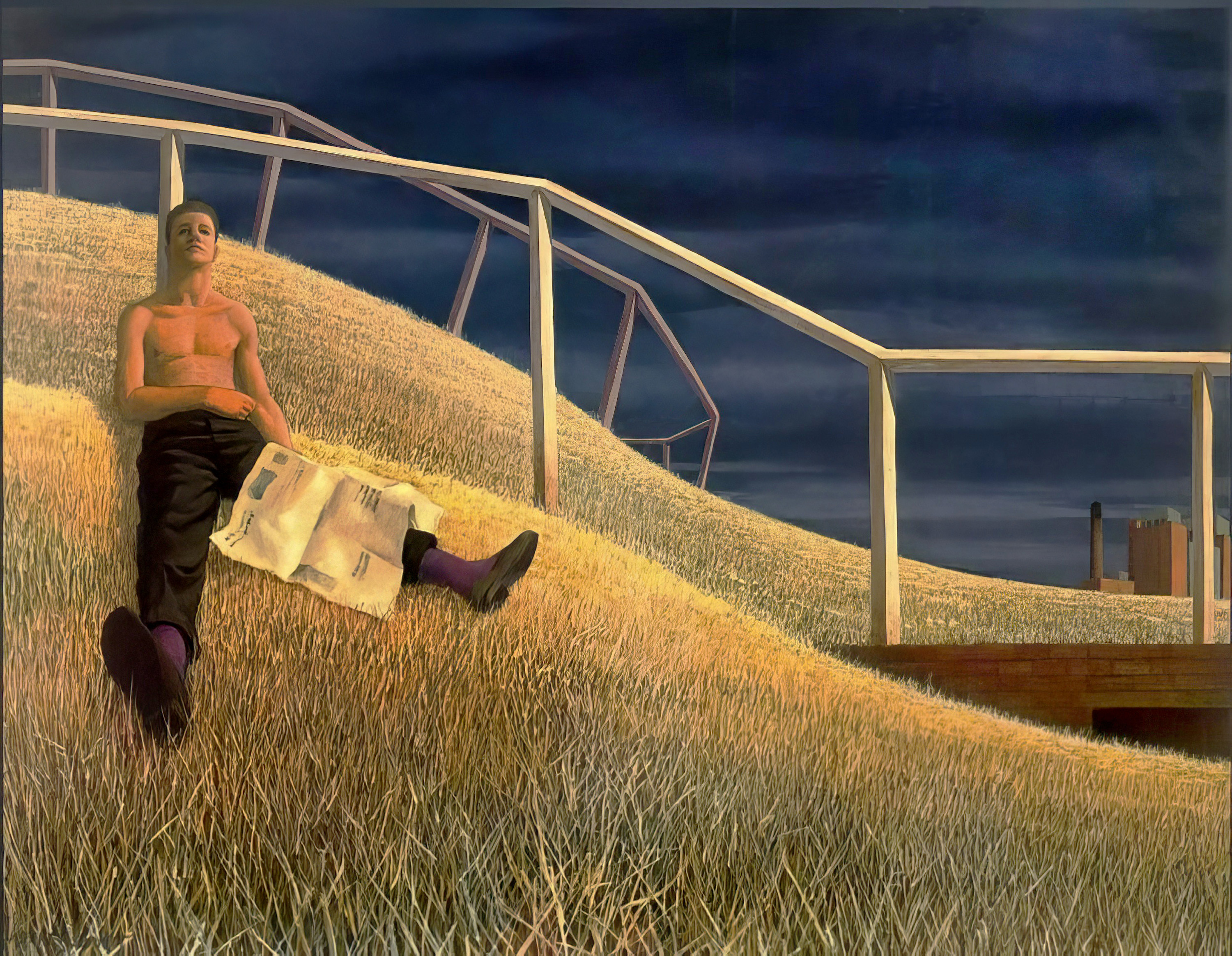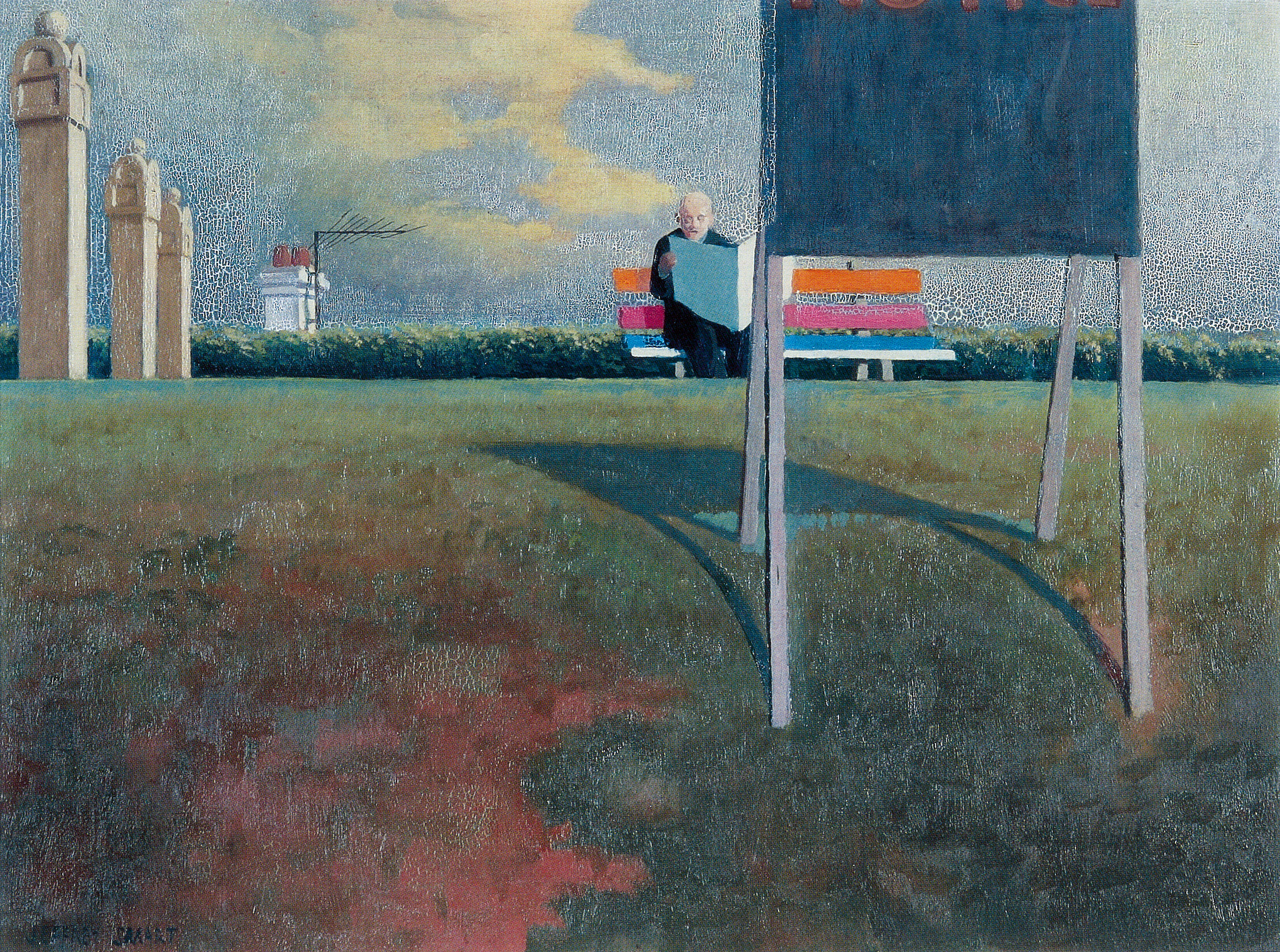THE PARK, 1959
JEFFREY SMART
oil on plywood
59.0 x 76.0 cm
signed lower left: JEFFREY SMART
signed and inscribed verso: MC.CAUGHEY PRIZE / “PARK” 75gns / Jeffrey Smart
A.G.B. Burney, London, acquired in February 1960
Private collection, Melbourne
Sotheby’s, Melbourne, 27 August 2007, lot 10
Private collection, Sydney, acquired from the above
Deutscher and Hackett, Melbourne, 4 May 2016, lot 37
Private collection, Melbourne, acquired from the above
Jeffrey Smart, Macquarie Galleries, Sydney, 15 – 23 September 1959, cat. 4 (as ‘Park at Kensington’)
possibly John McCaughey Memorial Prize, National Gallery of Victoria, Melbourne, November 1959
Recent Australian Painting, Whitechapel Gallery, London, 2 June – 23 July 1961, cat. 100 (label attached verso, dated 1960)
Destination Sydney: re-imagined, S.H. Ervin Gallery, Sydney, 7 December 2018 – 17 March 2019 (illus. in exhibition catalogue, p. 110)
Robertson, B., (ed.), Recent Australian Painting, The Arts Council of Great Britain, London, 1961, cat. 100, p. 28 (dated 1960) “Collection: A.G.B. Burney, Esq., London”
Quartermaine, P., Jeffrey Smart, Gryphon Books, Melbourne, 1983, cat. 348, p. 106 (as oil on canvas)
Allen, C., Jeffrey Smart, Unpublished Paintings, Australian Galleries, Melbourne, 2008, p. 95 (illus., dated 1961)
Pearce, B., Master of Stillness: Jeffrey Smart, Wakefield Press, Adelaide, 2015, revised edition, p. 57 (illus.)
Rolón, C., Common Practice Basketball and Contemporary Art, Skira Italy, 2020, p. 35 (illus.)
We are grateful to Stephen Rogers, Archivist for the Estate of Jeffrey Smart, for his assistance with this catalogue entry.
SMART-(cleaned).jpg

In 1960, at a particularly fertile point in his burgeoning career as an artist and popular children’s broadcaster Phidias from The Argonauts Club, Jeffrey Smart was invited to participate in Bryan Robertson’s exhibition Recent Australian Painting, to be held at the Whitechapel Gallery in London in June and July 1961. This landmark exhibition aimed to broadly champion the works of young Australian artists in London (one-fifth of whom had already begun living there) and to dispel preconceived notions of antipodean art as formulaically figurative and landscape-based. The painting Smart brought to the designated collection point, different to the one originally chosen by Robertson, was the curiously absurd The stilt race, 1960.1 Smart explained in a subsequent letter to Ann Forsdyke, Robertson’s assistant director, that a second work, esteemed to be amongst his best to date, would also be loaned from a private collection in London to provide a more complete demonstration of his individual ‘style’: The park, 1959.2
Although it was presented somewhat nondescriptly at Whitechapel Gallery in 1961 as ‘The Park, 1960’, new archival research has identified this important work as The park, 1959, originally exhibited in the artist’s solo exhibition in September of 1959 at Sydney’s Macquarie Galleries. Painted in Sydney a few years before the artist permanently relocated to Europe in 1963, The park was one of the largest paintings in the exhibition which, like Smart’s previous solo shows at Macquarie, was dominated by small formats.3 Although the painting was purchased from this exhibition by Mr Burney of London, it appears that the artist nevertheless in November 1959 submitted the painting to the lucrative John McCaughey Memorial Prize at the National Gallery of Victoria, championing paintings of ‘an Australian landscape of a realistic nature’ or ‘some aspect of the Australian scene or way of life.’4
Indeed depicting an Australian landscape, if only in name, The park belongs to a key group of enigmatic paintings of Sydney parklands, including Centennial Park, 1959 and Park at Paddington, 1959 of the same year, then Beare Park, 1961; Newtown Oval, 1961; Trumper Park, 1961; Cooper Park I, 1961, and Cooper Park II, 1962. With a cinematic tenor central to Smart’s style, the surging bright green hill of The park is crowned by an array of exposed street furniture, including a slightly skewed rubbish bin, a drinking fountain and forlorn basketball hoops painted in pale tones that almost glow under Smart’s floodlight effect. A discarded newspaper is placed in the foreground beside a vacant, candy-striped park bench, suggestive of a dead-letter drop. An anonymous woman in a dappled coat is glimpsed walking off-stage, her identity further concealed by an umbrella. The motif of a multicoloured bench was repeated within the smaller Park at Paddington, also shown in the Macquarie exhibition, this time occupied by a seated man who reads the newspaper. In this larger composition, the deserted, disquieting stillness, foreboding inky black sky and shuttered presence of the building all serve to create a heightened tension, perhaps implying an atmosphere of surveillance familiar from news and popular culture in these years of escalating Cold War crises.
Jeffery Smart Sup image-Park at Paddington).jpg

While The stilt race was animated by a cacophony of optical instructions provided by competing road markings and signs, The park presents a purified distillation of Smart’s formal concerns of the interplay of light, colour and form. The incongruous surrealism and magical realist qualities inherent in Smart’s early paintings are here only hinted at, hidden within unremarkable urban architecture and the barest of anodyne motifs.5 The careful placement of these objects throughout the picture plane corrals the eye in a circular path towards the lone figure, compositionally following the geometry of the golden mean. This underlying geometric principle was imparted by leading South Australian modernist, Dorrit Black, who gave Smart and Jacqueline Hick informal art lessons in Adelaide in the 1930s and 1940s. In particular, Smart adopted from Black the pursuit of consummate composition: ‘Dorrit taught us above all to make pictures, to examine the bare bones of composition. The design, the composition, was all-important. The word that impressed was “when you make a picture”.’6
The park is a quintessential example of Smart’s orchestration of space and perspective into a striking design. The flat, green vibrancy of the hill, abutting against a thunderous sky creates a false horizon, preventing us from seeing the basketball court implied by the presence of the pair of hoops and the city below. The smooth application of colour and erasure of superfluous details furthers the theatrical impression, presenting the hill as a planar stage set. The same structural device, reminiscent of American painter Andrew Wyeth’s 1948 masterpiece, Christina’s World, can be found throughout Smart’s oeuvre, from a rocky mound in the otherworldly scene of The [nun’s] picnic, 1957 to the bristling grassy hillside of Cooper Park I, 1962 and The listeners, 1965. Many of these works also feature a lone building placed on the horizon, their brick and painted Victorian architecture reminiscent of the works of Edward Hopper. Here, it is a monolithic brick warehouse existing entirely in the shadows. While the irregular patterns of its open and closed shutters suggest human occupancy, now they are still, revealing nothing but darkness.
1. The stilt race, 1960 was purchased shortly after the Whitechapel exhibition by the Art Gallery of New South Wales, joining two earlier works from 1946 and 1954
2. Letter dated 16 May 1961, cited in Pierce, S., Australian Art and Artists in London, 1950 – 1965. An Antipodean Summer, Ashgate, London, 2012, pp. 109, 135
3. Pearce, B., Jeffrey Smart, Beagle Press, Sydney, 2005, p. 122
4. Kane, B., The John McCaughey Memorial Prize. 50 Years, National Gallery of Victoria, Melbourne, 2008, np.
5. ‘Exhibition of Paintings by Jeffrey Smart’, Sydney Morning Herald, 15 September 1959, p. 2 and Lynn, E., ‘Smart Surrealist’, Vogue Australia, March 1967, p. 106
6. Smart, J., Not Quite Straight. A Memoir, William Heinemann Australia, Melbourne, 1996, p. 57
LUCIE REEVES-SMITH


